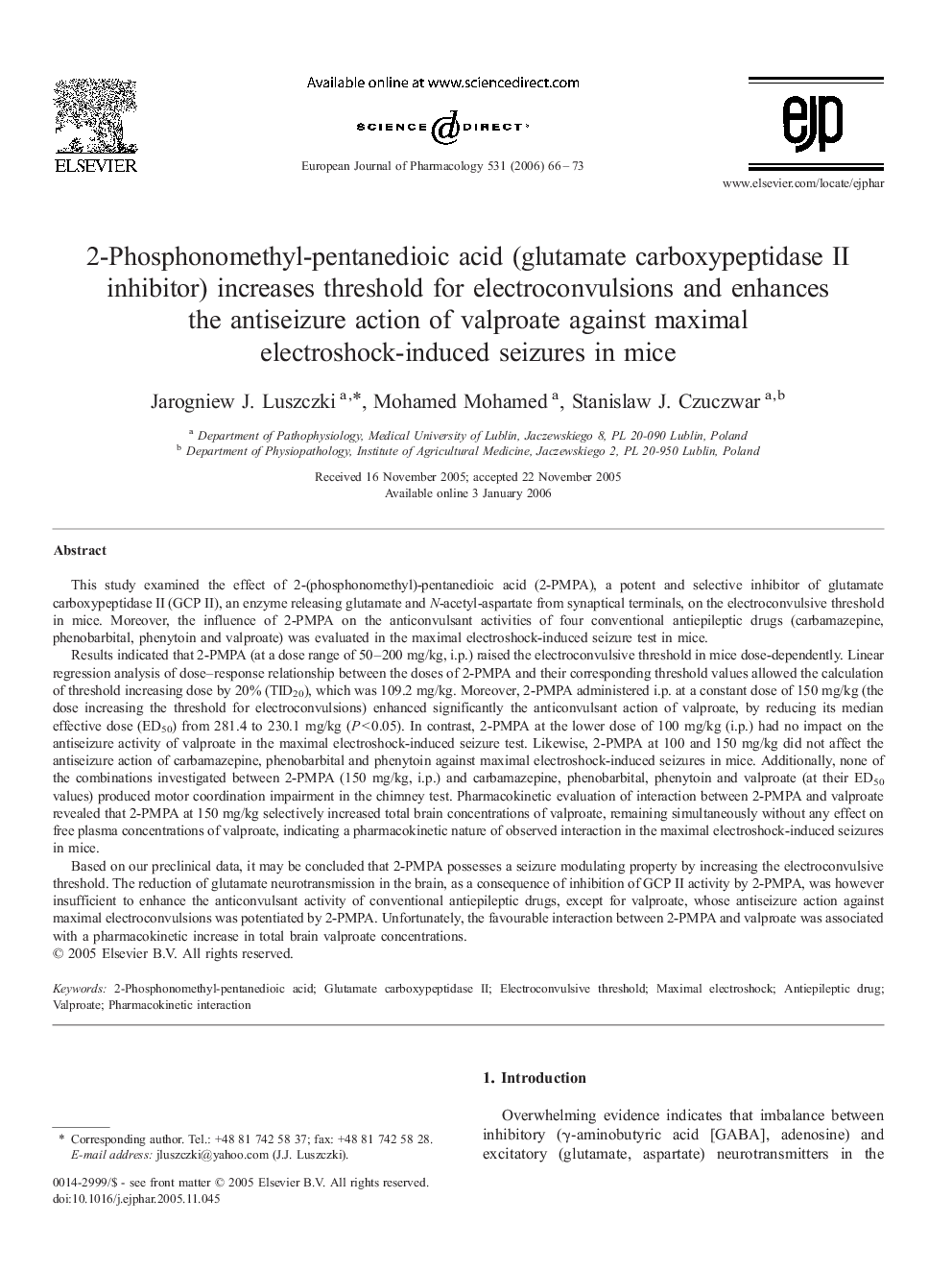| کد مقاله | کد نشریه | سال انتشار | مقاله انگلیسی | نسخه تمام متن |
|---|---|---|---|---|
| 2537406 | 1559190 | 2006 | 8 صفحه PDF | دانلود رایگان |

This study examined the effect of 2-(phosphonomethyl)-pentanedioic acid (2-PMPA), a potent and selective inhibitor of glutamate carboxypeptidase II (GCP II), an enzyme releasing glutamate and N-acetyl-aspartate from synaptical terminals, on the electroconvulsive threshold in mice. Moreover, the influence of 2-PMPA on the anticonvulsant activities of four conventional antiepileptic drugs (carbamazepine, phenobarbital, phenytoin and valproate) was evaluated in the maximal electroshock-induced seizure test in mice.Results indicated that 2-PMPA (at a dose range of 50–200 mg/kg, i.p.) raised the electroconvulsive threshold in mice dose-dependently. Linear regression analysis of dose–response relationship between the doses of 2-PMPA and their corresponding threshold values allowed the calculation of threshold increasing dose by 20% (TID20), which was 109.2 mg/kg. Moreover, 2-PMPA administered i.p. at a constant dose of 150 mg/kg (the dose increasing the threshold for electroconvulsions) enhanced significantly the anticonvulsant action of valproate, by reducing its median effective dose (ED50) from 281.4 to 230.1 mg/kg (P < 0.05). In contrast, 2-PMPA at the lower dose of 100 mg/kg (i.p.) had no impact on the antiseizure activity of valproate in the maximal electroshock-induced seizure test. Likewise, 2-PMPA at 100 and 150 mg/kg did not affect the antiseizure action of carbamazepine, phenobarbital and phenytoin against maximal electroshock-induced seizures in mice. Additionally, none of the combinations investigated between 2-PMPA (150 mg/kg, i.p.) and carbamazepine, phenobarbital, phenytoin and valproate (at their ED50 values) produced motor coordination impairment in the chimney test. Pharmacokinetic evaluation of interaction between 2-PMPA and valproate revealed that 2-PMPA at 150 mg/kg selectively increased total brain concentrations of valproate, remaining simultaneously without any effect on free plasma concentrations of valproate, indicating a pharmacokinetic nature of observed interaction in the maximal electroshock-induced seizures in mice.Based on our preclinical data, it may be concluded that 2-PMPA possesses a seizure modulating property by increasing the electroconvulsive threshold. The reduction of glutamate neurotransmission in the brain, as a consequence of inhibition of GCP II activity by 2-PMPA, was however insufficient to enhance the anticonvulsant activity of conventional antiepileptic drugs, except for valproate, whose antiseizure action against maximal electroconvulsions was potentiated by 2-PMPA. Unfortunately, the favourable interaction between 2-PMPA and valproate was associated with a pharmacokinetic increase in total brain valproate concentrations.
Journal: European Journal of Pharmacology - Volume 531, Issues 1–3, 15 February 2006, Pages 66–73